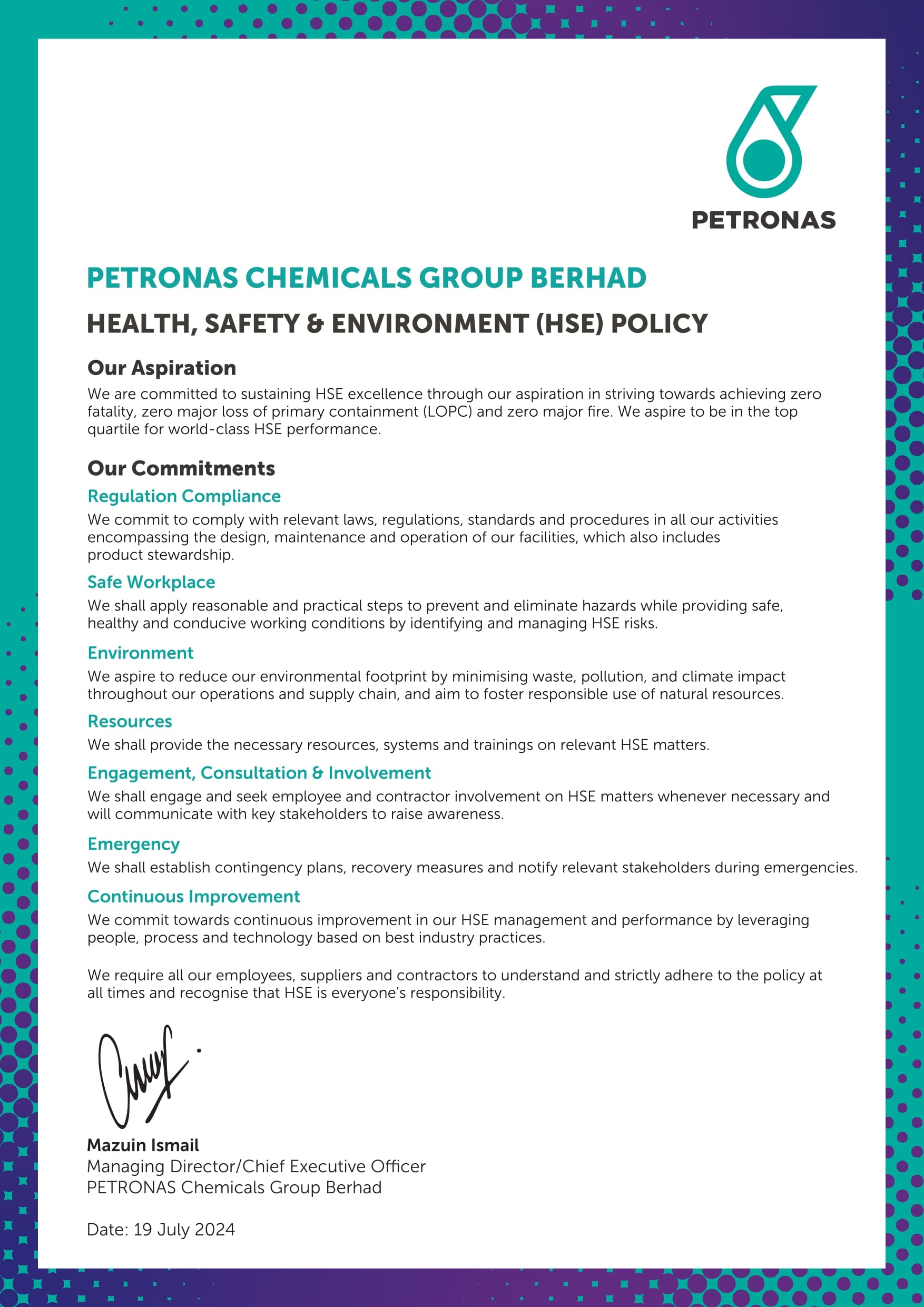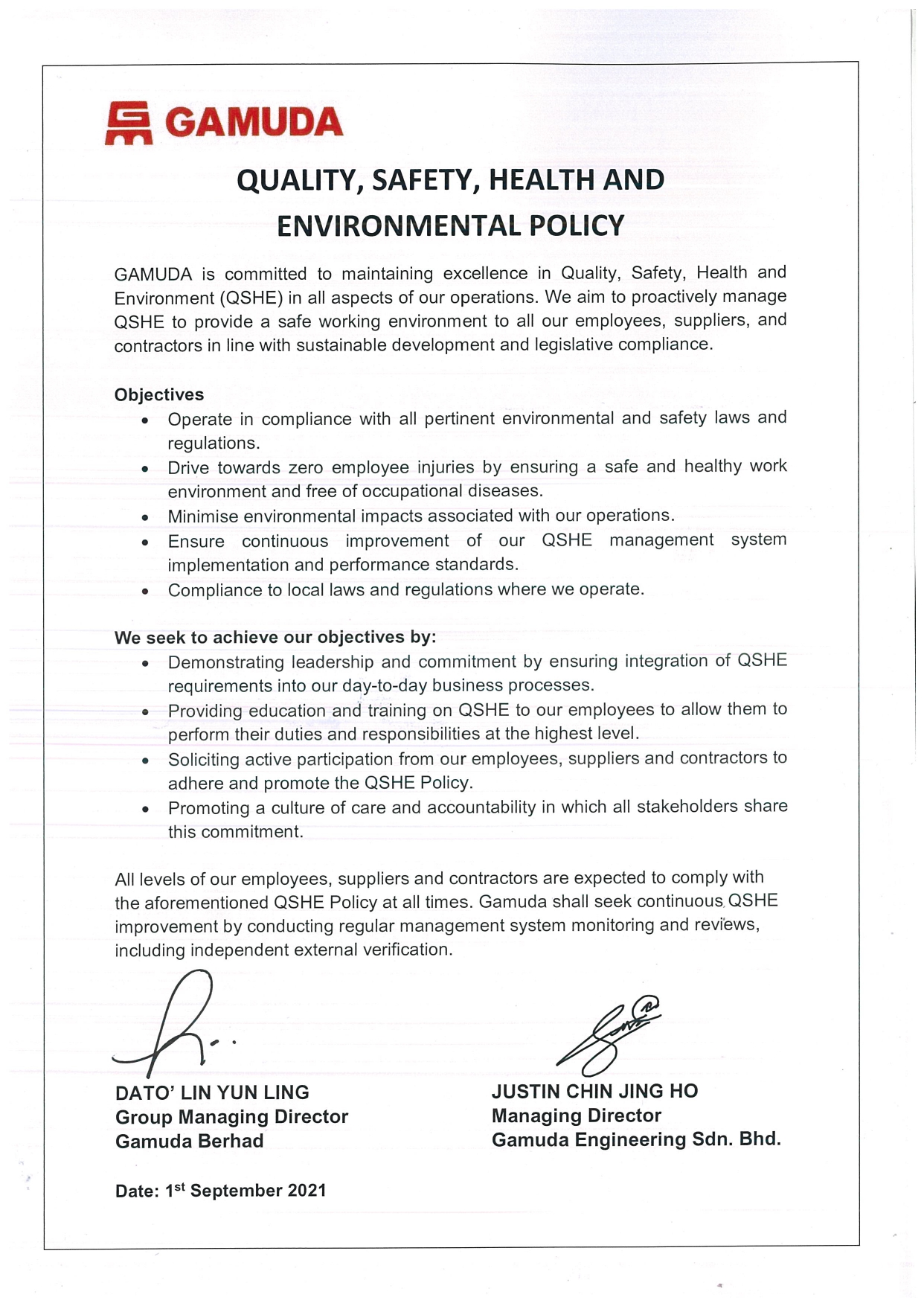A safety policy is one of the most important documents an organization can develop to protect its workforce and ensure compliance with occupational health and safety requirements. Whether your company operates in manufacturing, construction, logistics, or office environments, a clear safety policy sets the foundation for safe practices and responsible management.
Beyond legal compliance (Section 16, OSHA 1994), a safety policy demonstrates leadership commitment, reassures employees, and builds trust with clients and regulators. When aligned with recognized frameworks such as ISO 45001, it becomes a powerful tool to reduce risks, prevent accidents, and improve organizational resilience.
In this article, we will guide you step by step on how to write a safety policy that is practical, effective, and easy to communicate. To make it even more useful, we will share real-world samples from industry leaders so you can see how top organizations structure their policies and apply them in daily operations.
- What is a Safety Policy?
- Why a Safety Policy is Critical for Organizations?
- Key Elements of a Strong Safety Policy
- Elements That Should Be Considered in a Safety Policy
- Step-by-Step Guide – How to Write a Safety Policy
- Common Mistakes to Avoid
- Safety Policy Samples From Industry Leaders
- How ISO 45001 Aligns With Safety Policies
- Communicate the Policy Effectively Across Various Channels
- Conclusion – Turning Commitment Into Action
What is a Safety Policy?
A safety policy is a formal statement that outlines an organization’s commitment to providing a safe and healthy workplace for all employees, contractors, and visitors. It defines the principles and intentions of the management team regarding occupational health and safety, setting the direction for all safety-related activities within the organization.
Unlike detailed procedures or work instructions, a safety policy is a high-level document. It communicates the company’s values, establishes accountability, and sets objectives that guide everyday practices. For example, it may declare the organization’s dedication to preventing workplace accidents, complying with legal requirements, and continuously improving safety performance.
In many industries, having a written safety policy is not optional but a legal requirement. It is also a core element of internationally recognized standards such as ISO 45001, which emphasizes leadership responsibility in defining and maintaining an occupational health and safety management system (OHSMS).
Ultimately, a safety policy serves as a public declaration of the organization’s priorities, protecting people, safeguarding operations, and promoting a culture of safety across all levels.
Why a Safety Policy is Critical for Organizations?
A written safety policy is more than a document to satisfy regulators; it is a cornerstone of responsible management. Organizations that prioritize safety send a clear message to employees, clients, and stakeholders that they value human life and well-being above all else.
From a legal perspective, most jurisdictions require companies to maintain a safety policy as part of their occupational health and safety obligations. Failure to comply can lead to penalties, legal action, or even shutdowns in the event of serious incidents. By having a robust safety policy, businesses demonstrate due diligence and reduce their exposure to liability.
Beyond compliance, a safety policy drives measurable benefits. It helps to reduce workplace accidents, improves employee morale, and increases productivity by creating a safe and secure environment. Workers are more engaged and motivated when they see that management actively supports their health and safety. In addition, clients and partners often view a strong safety policy as a mark of professionalism and reliability, which enhances the organization’s reputation and competitiveness.
For organizations pursuing ISO 45001 certification, the safety policy plays a central role. It links strategic objectives with day-to-day practices, ensuring that safety is not treated as an afterthought but as an integral part of business operations.
Key Elements of a Strong Safety Policy
An effective safety policy must be more than a general statement of intent. It should contain clear elements that reflect the organization’s values, responsibilities, and approach to workplace safety. The following components are essential:
1. Leadership Commitment
The policy must highlight management’s responsibility for protecting workers and preventing harm. This demonstrates genuine leadership involvement rather than delegating safety as a minor task.
2. Clear Objectives and Scope
It should define the purpose of the policy, the activities and locations it covers, and the overall safety goals of the organization, such as eliminating hazards or reducing incident rates.
3. Defined Roles and Responsibilities
A good safety policy assigns accountability to different levels of the organization, from top management to supervisors and employees. Everyone must understand their role in maintaining safety.
4. Compliance and Risk Management
The document should state the organization’s commitment to complying with legal requirements, industry regulations, and international standards like ISO 45001. It should also acknowledge the role of risk assessment in preventing accidents.
5. Communication and Training
The policy must emphasize the importance of raising awareness, providing training, and ensuring that employees are equipped to follow safe practices.
6. Continuous Improvement
A safety policy is not static. It should include a pledge to regularly review and improve safety performance, integrating lessons learned from incidents, audits, or feedback.
When these elements are present, the policy not only meets compliance requirements but also serves as a living framework that guides decision-making and daily behavior across the organization.
Elements That Should Be Considered in a Safety Policy
When drafting a safety policy, it is important to include specific elements that make the document both practical and credible. These elements ensure the policy is not just symbolic, but actionable and enforceable.
Key Elements to Consider
- Statement of Intent – A clear declaration that the organization is committed to protecting the safety and health of its employees, contractors, and visitors.
- Legal and Regulatory Compliance – Acknowledgement of responsibility to meet applicable occupational safety and health laws, regulations, and standards such as ISO 45001.
- Scope of Application – Clarity on which facilities, activities, and personnel the policy applies to, including contractors and suppliers where relevant.
- Roles and Responsibilities – Defined accountability for senior management, supervisors, safety officers, and employees.
- Risk Management – Recognition of the need to identify, evaluate, and control workplace hazards systematically.
- Resources and Training – Assurance that sufficient resources, skills, and training will be provided to support safe practices.
- Communication and Consultation – A framework for sharing information with employees and engaging them in safety initiatives.
- Performance Measurement and Review – A commitment to monitor safety performance, conduct audits, and review the policy regularly.
Commitments That Must Be Reflected
A strong safety policy must explicitly demonstrate the following commitments:
- Commitment to Prevention of Injuries and Ill-Health – Protecting people is the primary purpose of the policy.
- Commitment to Legal and Other Requirements – Full compliance with local laws, industry codes, and contractual obligations.
- Commitment to Worker Participation – Encouraging employee involvement in hazard reporting, safety committees, and decision-making.
- Commitment to Continuous Improvement – Ongoing efforts to improve safety management systems, reduce risks, and adopt better practices.
- Commitment to Leadership and Accountability – Senior management takes ultimate responsibility for safety outcomes and leads by example.
By embedding these elements and commitments, a safety policy becomes more than a statement on paper. It becomes a living framework that strengthens trust and builds a safety culture across the organization.
Step-by-Step Guide – How to Write a Safety Policy
Writing a safety policy may seem challenging, but by breaking it down into structured steps, any organization can develop a clear and practical document. Below is a systematic approach:
Step 1 – Gather Legal and ISO 45001 Requirements
Start by reviewing local occupational health and safety laws, industry-specific regulations, and relevant international standards. This ensures the policy reflects mandatory obligations as well as best practices.
Step 2 – Identify Organizational Risks and Scope
Define the scope of the policy by identifying the activities, processes, and locations it will cover. Conduct a risk assessment to understand the main hazards that the policy should address.
Step 3 – Draft Key Statements
Write the core statements of the policy, including management’s commitment to safety, legal compliance, prevention of injuries, and continuous improvement. These should be short, clear, and easy to understand.
Step 4 – Consult Stakeholders and Employees
Involve employees, supervisors, and safety representatives in reviewing the draft. Consultation not only improves the quality of the policy but also builds buy-in across the workforce.
Step 5 – Secure Top Management Approval
A safety policy must be endorsed at the highest level of the organization. Senior leaders should sign and publicly support the policy, demonstrating visible commitment.
Step 6 – Communicate and Integrate
Share the approved policy with all employees and stakeholders. Post it in visible areas, include it in onboarding training, and integrate it into operational procedures.
Step 7 – Establish Review and Update Cycle
Commit to reviewing the policy regularly at least annually or whenever there are significant changes in operations, legislation, or risks. This keeps the policy relevant and effective.
Common Mistakes to Avoid
Even well-intentioned organizations often make errors when drafting their safety policies. Recognizing these pitfalls can help ensure your policy is practical, credible, and effective.
1. Using Vague or Generic Language
A statement such as “We care about the safety of our people” sounds positive but does not show how the organization will protect workers. Instead, the policy should state, for example: “We are committed to eliminating workplace hazards through regular risk assessments and safe work procedures.”
2. Copying Templates Without Customization
Many companies adopt pre-written templates and simply replace the company name. For instance, a construction company might copy a manufacturing template that talks about “machine guarding,” even though it has no relevance to its work. This weakens the policy and may create compliance gaps.
3. Failing to Secure Top Management Support
A safety policy that is drafted by the safety officer alone, without being signed or endorsed by top management, sends the message that leadership is not truly accountable. Employees quickly notice when management commitment exists only on paper.
4. Overlooking Employee Engagement
If the policy is written without input from employees, it may ignore practical challenges they face. For example, a policy may state that workers must always wear safety harnesses, but if the equipment is not easily available, the rule becomes impractical and discourages compliance.
5. Treating the Policy as a One-Time Document
A company that issued its safety policy five years ago and has never updated it will likely be out of step with new regulations or changes in its operations. A living policy must be reviewed regularly to stay relevant and effective.
By addressing these common mistakes, organizations can ensure their safety policy not only meets compliance needs but also inspires confidence and fosters a stronger safety culture.
Safety Policy Samples From Industry Leaders
To make the concept more practical, below are sample safety policy statements inspired by leading organizations across different industries. These examples demonstrate how commitments are tailored to each organization’s unique risks and operations.
Quality, Occupational Safety and Health Policy – DOSH Malaysia
It is the policy of the Department of Occupational Safety and Health (DOSH) to continuously improve the quality of products, services and the safety and health performance of DOSH staff as well as those related to them.
The management and employees of DOSH will work together to prevent any potential non-conformity of its products and services as well as any possible injuries and illnesses from incidents that occur in the workplace.
This department is committed to: –
- Provide and maintain a quality, safe and healthy work place and system free from any hazards and risks;
- Ensure that all DOSH employees are given information, instructions, training and supervision on how to carry out their duties safely and without risk to health;
- Investigate all non-conformities of its products and services, incidents, occupational diseases, occupational poisonings and dangerous occurrences and take steps to ensure that they do not recur;
- Identify and comply with customer requirements, legislation and other requirements as stipulated in the Occupational Safety and Health Act 1994, its regulations and approved industry codes of practice;
- Promote and achieve Quality, Occupational Safety and Health Objectives, Work Procedures, Occupational Safety and Health Regulations and Guidelines among DOSH employees nationwide.
To ensure the implementation of this policy, a Quality, Safety and Occupational Health Management system is established, implemented and maintained in this Department.
PETRONAS Health, Safety and Environment Policy – PETRONAS

Quality, Safety, Health and Environmental Policy – GAMUDA

How ISO 45001 Aligns With Safety Policies
ISO 45001, the international standard for occupational health and safety management systems, places strong emphasis on the role of a safety policy as the foundation of an effective system. In fact, the standard requires organizations to establish, implement, and maintain a documented policy that reflects leadership commitment and provides a framework for setting objectives.
Key ISO 45001 Clauses Related to Safety Policy
- Clause 5.2 – Occupational Health and Safety Policy: This clause requires that the policy is appropriate to the organization, includes a commitment to prevention of injury and ill health, compliance with legal requirements, and continual improvement.
- Clause 5.1 – Leadership and Commitment: Top management must take accountability for the effectiveness of the OHS management system, which includes endorsing and promoting the safety policy.
- Clause 6.2 – Objectives and Planning to Achieve Them: The policy provides the framework for setting measurable safety objectives that align with broader business goals.
By aligning the safety policy with ISO 45001 requirements, organizations gain several advantages:
- Audit Readiness: A compliant policy demonstrates to certification bodies that leadership is actively committed.
- Consistency Across Sites: The policy ensures uniform safety expectations, even across multiple locations.
- Continuous Improvement: Linking the policy to performance objectives supports ongoing monitoring, evaluation, and refinement.
In essence, ISO 45001 transforms a safety policy from a stand-alone document into a central element of a structured, auditable management system. This not only strengthens compliance but also drives a culture of accountability and proactive risk management.
Communicate the Policy Effectively Across Various Channels
A safety policy only has value if it is known, understood, and practiced by everyone in the organization. Simply posting it on a notice board or leaving it in a binder is not enough. Effective communication ensures that the commitments written in the policy become part of everyday workplace behavior.
1. Workplace Display
Place the signed policy in prominent locations such as entrances, notice boards, staff common areas, and site offices. This makes it visible to both employees and visitors, reinforcing organizational commitment.
2. Digital Platforms
Share the policy through the company intranet, email bulletins, and collaboration tools. For organizations with multiple sites or remote staff, digital access ensures everyone receives the same information.
3. Induction and Training
Introduce the policy during employee onboarding and reinforce it during refresher training sessions. Linking the policy to practical safety instructions helps workers see how it applies in daily tasks.
4. Toolbox Talks and Team Meetings
Supervisors should reference the policy in toolbox talks, safety briefings, or department meetings. This encourages open discussion and helps integrate the policy into operational routines.
5. External Communication
For contractors, suppliers, and clients, sharing the policy demonstrates professionalism and compliance. Publishing it on the company website or in corporate reports can also enhance brand reputation.
By communicating the safety policy through multiple channels, organizations make sure it is not just a document but a shared commitment. Consistent communication builds awareness, ownership, and accountability across all levels of the workforce.
Conclusion – Turning Commitment Into Action
A well-written safety policy is more than a regulatory requirement; it is a declaration of an organization’s values and a roadmap for protecting its most important asset, its people. By defining responsibilities, setting clear objectives, and committing to continuous improvement, the policy becomes the foundation for a safer and more resilient workplace.
Organizations that take the time to craft and implement a strong safety policy not only comply with laws and ISO 45001 requirements but also gain the trust of employees, clients, and regulators. The samples provided in this article show that the most effective policies are those that are simple, specific, and tailored to the realities of the industry.
If your organization has not yet developed a safety policy, or if your existing one feels outdated, now is the time to act. Start drafting, engage your workforce, and secure leadership endorsement. By doing so, you transform safety from a written statement into daily practice, building a culture where every worker goes home safe, every day.
